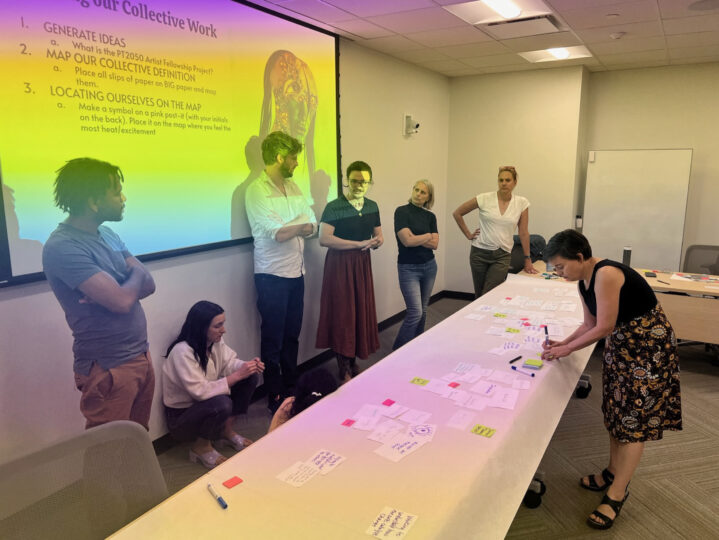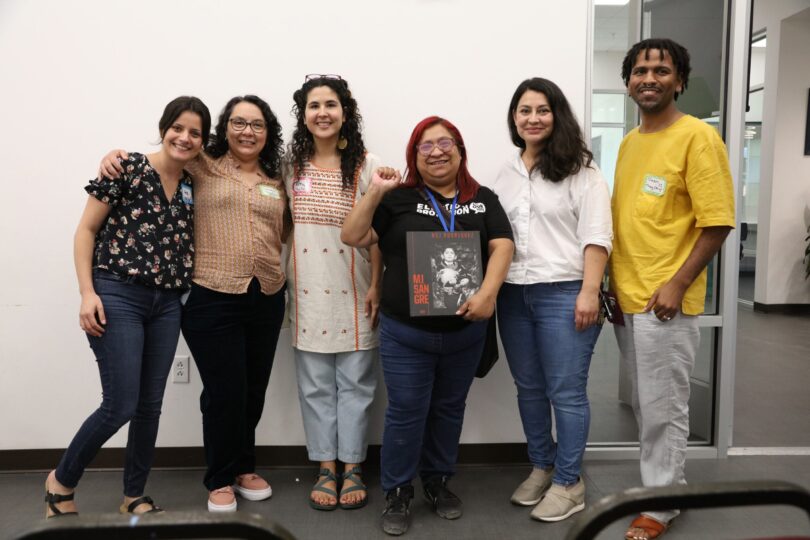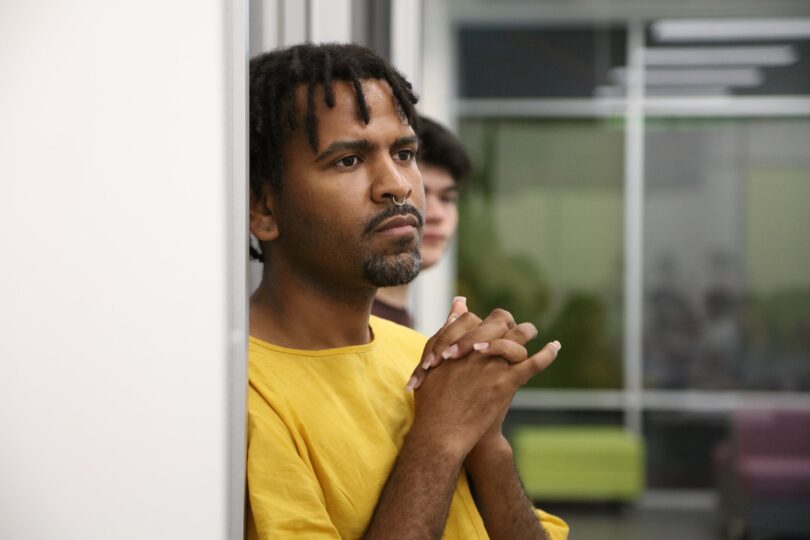Last academic year, Planet Texas 2050 piloted a new Artist Fellowship, inviting creatives from all disciplines to apply and contribute to research exploring the impacts of climate change. These artists would connect with their fellow cohorts and with PT2050 researchers, expanding their creative pursuits to deepen understandings of the climate crisis and community resilience. Faculty member Angelica Monteiro and M.F.A. candidate Deen Rawlins-Harris were among the eight artists selected for the first cohort of PT2050 Artist Fellows. We spoke with them, along with some key orchestrators behind PT2050’s fellowship, about the goals of this initiative and their experiences during the pilot year.
What was the driving purpose behind establishing the PT2050 Artist Fellowship?
Heidi Schmalbach (Program Director of PT2050 and co-developer of the Artist Fellowship): Artists and arts-based methods are critical to our mission: to strengthen interdisciplinary research on resilience and to help fortify Texas’ resilience through co-design of adaptive strategies with frontline communities and other stakeholders. Since the launch of PT2050 in 2017, it has been clear that scientific research alone is not enough to address the compounding challenges we face when it comes to climate adaptation and resilience. Artists bring many specific skills and tools to this work, which could fall under an umbrella like “making complex topics more legible and relevant,” but for me the most important work reminds us of our shared humanity and capacity for collective imagination. We created the PT2050 Artist Fellowship as a mechanism to foster relationships between our network of researchers and artists both in and outside of UT, with the hope that the time offered for immersion and exchange would lead to longer-term collaborations. We are starting to understand what some of these collaborations might look like, and that’s very exciting.
How was the fellowship structured to promote cross-disciplinary collaboration? What discoveries grew out of this structure?
Katie Dawson (Faculty member, head of Creative Collaborations for PT2050’s Theme Organizing Committee and co-developer of the Artist Fellowship): Educational scholar and activist bell hooks reminds us that “The function of art is to do more than tell it like it is – it’s to imagine what is possible.” We structured the fellowship to be emergent and inquiry-based. We know that the climate crisis transcends our ability to imagine its consequences so our goal was to harness the power of the arts as a language for multiple modes or ways of expression and meaning-making. We facilitated workshops with artists and scientists where we could share our different approaches for research and imagine new possibilities together. We considered the promise and power of the arts to address systemic problems. We found that it was important that we avoid a reductive orientation of the arts as helper or “instrument” of communication for science. We also worked to attend to the humanistic and natural concerns present in arts process and product in relationship to the climate crisis. Most importantly, we built new friendships and networks across the artist community in and outside UT Austin through this program. We have much more work to do but the start is promising.

What was it like watching collaborations and discoveries take place during the 22/23 Fellowship?
Khristián Méndez Aguirre (Ph.D. candidate, graduate assistant and co-developer of the Artist Fellowship): Perhaps my favorite aspect of the artist fellowship was the balance between openness and certainty that I saw in the individual artists and the flagship researchers. There was a shared certainty that the arts are important for climate research, climate justice even; but there was also an earnest openness to figure out what that looks like in practice. This was true of the sessions we facilitated with the PT2050 community at large, but also the participations in the PT2050 Symposium and the many spin-off conversations and tendrils of that work that have developed in Winship as a result of this partnership.
A conversation with two PT2050 Artist Fellows – Angelica Monteiro and Deen Rawlins-Harris
Talk about your experience as a PT2050 Artist Fellow. What was it like working with STEM researchers and fellow artists who share your interest in community resilience and combating the climate crisis?
Angelica Monteiro (Alum (M.F.A. 2022) and Lecturer in the Department of Theatre and Dance): I am an interdisciplinary artist and educator, meaning I bring movement, photography, video, painting and poetry to tell stories of resistance. In many settings that can feel overwhelming, since we are so used to boxing our work into categories, but not at PT2050. I felt seen and heard by the leadership and cohort of artists. The connection with scientists was harder to make for many reasons – schedule and understanding of dance being one of them. But considering that I was part of the first cohort ever, I looked at it with grace and patience. Programs like PT2050 deserve all the love.
One of the first things that struck me as a PT2050 Fellow was the fact that we didn’t have to have a “final” product. The process was truly valued, and the directors of the program led by example. Heidi, Katie and Khristián did a great job setting up the foundation of the fellowship which was “we are building whatever this is together.” Curiosity, collaboration and artistry fueled our conversations and actions.
…PT 2050 helped me expand to other pathways and collaborations. I am fairly new to Austin, and through the fellowship I met incredible artists and scientists with whom I had the pleasure to collaborate during the summer.

Deen Rawlins-Harris (current M.F.A. in Theatre candidate): I enjoyed my experience as a PT2050 artistic fellow because it was an opportunity to demonstrate and witness the ways artists use creativity to reveal human emotional responses to the research happening in the Planet Texas 2050 research projects and generate innovative ways to consider and engage data collected in the various STEM projects. When trying to find solutions to address the climate crisis, it is essential to encourage partnerships between STEM researchers and artists because the artistic process is excellent at collectively fostering imaginative solutions while highlighting why we have the understanding we do about climate change.
As a PT2050 Artist Fellow, I worked with Dell Medical Center researchers Carmen Valdez, Ana Chatham, Kathy Perez and Miriam Solis on their Youth PhotoVoice Project, a Youth Participatory Action Research Project led by the researchers from Dell Medical Center and the youth working with the City of Pharr, Texas. The youth researchers collected photos documenting how climate change and public infrastructure impact their lives and individually interpreted what they saw in the photo using a prescribed process.
To help them collectively contextualize their photos, I led them through a drama-based strategy I’m developing called Story-Time-Line. This strategy allows participants to build a collective narrative of a community by contemplating the place’s past, present and future. The youth researchers quickly adapted the strategy and prompts to fit their needs, and I love it when that happens. They translated questions into Spanish, answered the prompts through the perspective of other people in their lives and utilized the opportunity to make compassionate statements about immigration reform and safety, gender and sex discrimination, environmental justice and racial injustices.
This artistic practice revealed how the youth understood the relationship between their research photos and the world. We learned how the photos emotionally impacted them and represented their concerns and hopes about climate change. Researchers not only had the opportunity to learn what youth believed but why they believed it, too. This wisdom is vital because it helps us acknowledge the myths that inform youth’s understanding of climate change and develop lessons that help them be critical of the information they receive from their communities.
What discoveries did you make during your fellowship, both as a cohort and for your practice individually?

Deen Rawlins-Harris: I had the opportunity in this fellowship to conduct research meaningfully that reached folks outside of the 40 acres. I would not have had this extraordinary opportunity if I were not a member of this cohort and hadn’t received the financial support available to facilitate this type of interdisciplinary experience.
Angelica Monteiro: This process-driven program was valuable for me as an immigrant artist and climate advocate from the Brazilian Amazon. First, I was with like-minded artists that also saw their art as advocacy. Second, there was no pressure to be “productive” which is a revolutionary concept that goes against the capitalist mode of production that consumes all the meaning of art and packages it into digestible wraps. That counter-productive model gave us freedom to understand each other as a cohort, find the intersections between our works and learn from our expertise. Third, I found that PT2050 introduced me to possible lifelong partners within the creative advocacy world in Austin.
I believe that programs like PT2050 exist to support artists and scientists, but most importantly break boundaries and bridge the gap between science and the community through the arts. Artists can help not only to translate information, but also create and spread knowledge that lives within culture. Dance is a social science. The arts live within sciences.
The 22/23 PT2050 Artist Fellows also included Forklift Danceworks, under the direction of Allison Orr and Krissie Marty (B.F.A. 1993). PT2050 is a grand challenge of Bridging Barriers, a research development initiative at The University of Texas at Austin.
Written by Sydney Pattillo.

